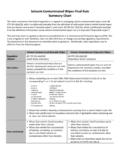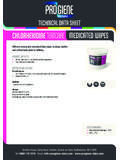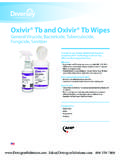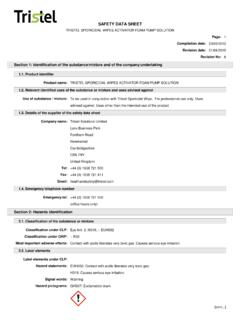Transcription of LEAD in DUST WIPES 9105 by Chemical Spot Test ...
1 NIOSH Manual of Analytical methods (NMAM), Fourth EditionLEAD in DUST WIPES9105 by Chemical Spot Test ( colorimetric screening Method) Pb MW: CAS: 7439-92-1 RTECS: OF7525000 METHOD: 9105, Issue1 EVALUATION: PARTIALI ssue 1: 15 March 2003 OSHA:no PELNIOSH:no RELACGIH:no TLVPROPERTIES:soft metal; d g/cm3; MP oCvalences +2, +4 in saltsSYNONYMS:Elemental lead and lead compounds except alkyl leadSAMPLINGMEASUREMENTSAMPLER: wipe , meeting the specifications of ASTME1792 [1].SAMPLE:Human skin ( , hands) or non-dermalsurfaces ( , floors, walls, furniture)SAMPLESTABILITY:StableBLANKS:A t least 5% of samples, min. of 2 per batchTECHNIQUE: Chemical SPOT TEST, Rhodizonate-based solution or spot test kit applied towipe sample [2]ANALYTE:Rhodizonate complex of leadPOSITIVEINDICATOR:Observed color change on wipe fromyellow/orange to pink/red (under acidicconditions) [2,3]RESPONSE:The method is ordinarily positive for thepresence of lead in the range of 5 -15 :g/sample, upwards to and exceedingmilligram amounts [3,4].
2 ACCURACYRANGE STUDIED:< to >1,000 g Pb per wipeBIAS:Not applicableOVERALL PRECISION ( rT):Not applicableACCURACY:Response may differ for different wipematerials, different matrices anddifferent rhodizonate : This is a qualitative, colorimetric screening method, designed for field use. The method was designed as ahandwipe method for human skin, but is also applicable to various non-dermal surfaces including floors, walls, furniture, etc. Acharacteristic color change on the wipe ( , from yellow/ orange to pink/ red hues) indicates the presence of lead. Byestimating the performance parameters for a given wipe /rhodizonate solution combination, the performance characteristics canbe evaluated [5]. If quantitative results are needed, lead in the wipe samples can be measured on-site using a modification ofNIOSH method 7701, or in a fixed-site laboratory using NIOSH methods 7082, 7105, 7300, or : Tl+, Ag+, Cd2+, Ba2+, and Sn2+ also form colored compounds with rhodizonate ion, but with less sensitivitythan that of Pb2+, and only the lead-rhodizonate complex gives the characteristic pink or red color [3].
3 Interferences from thewipe medium, , surfactants, are possible. OTHER methods : Laboratory methods for the determination of lead in dust WIPES include modifications of NIOSH methods7082 (Lead by Flame AAS), 7105 (Lead by Graphite Furnace AAS), 7300 (Elements by ACP), and 7701 (Lead by PortableASV).LEAD IN DUST WIPES : METHOD 9105, Issue 1, dated 15 March 2003 - Page 2 of 3 NIOSH Manual of Analytical methods (NMAM), Fourth EditionREAGENTS:1. Vinegar ( , 5% acetic acid as whitevinegar) or 1% nitric acid (v/v).*2. Sodium or potassium rhodizonate salt(rhodizonic acid).NOTE: Rhodizonate solutions may degradequickly over time. Solutions should beprepared fresh daily and kept Distilled or deionized water.* See SPECIAL pump spray bottles (fine spraypreferred) with a capacity of at least 125 for sample collection, meeting thespecifications of ASTM E1792 [1].
4 Glasses or , vinyl disposable or powderless vials, plastic screw top containersor plastic centrifuge :Commercial kits are PRECAUTIONS: If 1% nitric acid is used, use common sense safety precautions whenhandling the solution ( , wear vinyl gloves, safety glasses/goggles, and avoid contact with clothingand exposed skin).SAMPLING:Dermal surfaces ( , hands): workplace dermal sampling, tear open a wipe packet and without touching the wipe , offer the wipeto the employee to be the employee to remove the wipe from the packet, and unfold the person to wipe the palms first, then the top surfaces of both sides of his or her hands(using normal hand washing pressure). Tell the employee to wipe using the same side of the wipe ,and to continue wiping his/her hands for a period of not less than 30 (non-dermal) surfaces: wipe samples in accordance with ASTM E1728 [6], or use the following gloved hands, open a wipe packet and unfold the a delineated (known) area of the surface, being sure to cover the entire area across the surface using repeated horizontal wipe the same surface again using the same side of the wipe for sampling, and wipe at a rightangle to the first wiping a new pair of clean gloves for successive wipe PREPARATION:NOTE:The following procedure is written for sodium rhodizonate, and can be amended usingpotassium rhodizonate.
5 Also, commercial spot test kits may be used to test for lead on wipesamples in lieu of the procedure described below, but skin contact with the reagents shouldbe a solution of rhodizonic acid using the sodium rhodizonate powder. Dissolve a pre-weighedportion of grams (135 mg) in 105 cc of very cold water (~2 oC). This is the indicator indicator solution should turn an orange color when a quantity of the indicator solution into one of the spray bottles, label the bottle: #2 or leadindicator solution. Refrigerate the remaining another spray bottle with household vinegar or make up a 1% (v/v) nitric acid solution, label thatbottle #1 or lead extraction 1:The indicator solution will remain active for 2-3 days (if kept cold). After a time the indicatorsolution will begin to turn color (pale yellow) and lose viability, at which time a new solutionLEAD IN DUST WIPES : METHOD 9105, Issue 1, dated 15 March 2003 - Page 3 of 3 NIOSH Manual of Analytical methods (NMAM), Fourth Editionmust be mixed.
6 A new indicator solution should be prepared at least daily, especially if notrefrigerated at a very low temperature (approaching 0 oC). The lead disclosing solutionshould be kept cold where possible ( , recommend to use a small cooler for field storageof indicator solution). NOTE 2:Alternative solutions and test indicators may be used, and this can alter the sensitivityand selectivity of the test for sample ( wipe ) on clean with 3 pumps of bottle #1 (vinegar) extraction solution. wipe with 2 pumps of bottle #2 (indicator solution). sample turns red, lead is present. If no color change, sample is considered 3:For quantitative analysis, see Method 7300 for OF METHOD:The method has been evaluated preliminarily using ASTM E1792 [1] WIPES spiked with certified referencematerials (CRMs), and has been found to give a positive response for at least ten micrograms of lead perwipe.
7 The method has also been subjected to limited field testing, and shows a positive response for at leasta few tens of micrograms of lead per wipe . Extremely heavy soiling on the wipe could interfere withvisualization of the red color change due to darkening of the wipe , but the pink or red hues should still bevisible around the area of the heaviest soiling, provided lead is present. Difficult matrices ( , dust wipescontaining paint chips) may require leaching in dilute nitric acid before spot testing. Persons with color blindness may not be able to detect the pink or red hues characteristic of this spot :[1]ASTM [2002]. ASTM E1792-02, Standard specification for wipe sampling materials for lead in surfacedust. In: Annual Book of ASTM Standards, Vol.
8 West Conshohocken, PA: American Society forTesting and Materials.[2]Esswein EJ, Boeniger M, Ashley K [2001]. Handwipe disclosing method for the presence of lead. No. 6,248,593.[3]Feigel F, Anger V [1972]. Spot tests in Inorganic Analysis. Amsterdam: Elsevier, pp. 282-287, 564-566,569.[4]Ashley K, Fischbach TJ, Song R [1996]. Evaluation of a Chemical spot test kit for the detection of airborneparticulate lead in the workplace. Am. Ind. Hyg. Assoc. J. 57:161-165.[5]Song R, Schlecht PC, Ashley K [2001]. Field screening test methods Performance criteria andperformance characteristics. J. Hazard. Mater. 83:29-39.[6]ASTM [2002]. ASTM E 1728-02, Standard practice for field collection of settled dust samples using wipesampling methods for lead determination.
9 In: Annual Book of ASTM Standards, Vol. WestConshohocken, PA: American Society for Testing and WRITTEN BY:Eric J. Esswein, NIOSH/DSHEFS, and Kevin Ashley, NIOSH/DART.















